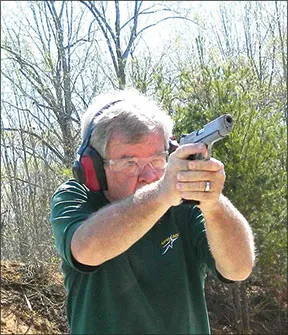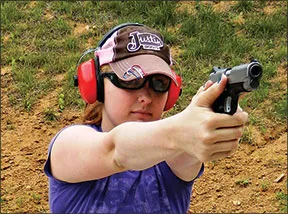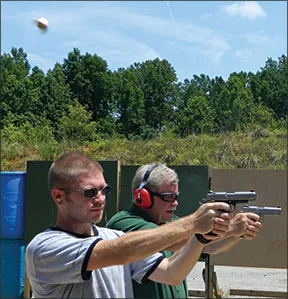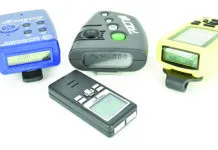Some accuse 1911 fans of believing the sun rises and sets on the big 45 ACP. And it is a certainty that the full-size pistol has played an important role in many lives as a badge of office, tool of the trade, a lifesaver, a game taker, and a sporting instrument. Some claim that when their hands wrap around the 1911s handle, it says friend like no other pistol. The 1911 has prevailed in innumerable engagements because it fits most hands well and features well-placed controls. Also, the 1911 fires a powerful cartridge, but not so powerful that most of us cannot control it.

Digging down further, another great advantage of the 1911 is a straight-to-the-rear trigger compression. No need to lay the finger above the trigger and swing it down in an arc as is necessary with the double-action first shot pistol. Also, the trigger resets rapidly, and the slide lock safety and grip safety offer a combination of safety features not found on many handguns. But the full-size 1911 has its downsides as well – mainly, it is big and heavy.
So, to keep the advantages of the design and to mitigate its shortcomings, many civilian carriers have adopted shorter and lighter 1911s of the Commander size. The original Colt Commander featured a barrel and slide -inch shorter than the 5-inch Government Model. The Commander pistol also had an aluminum frame, making it lighter. Later, the steel-frame Combat Commander was introduced. Some stated that inch off the slide was pointless when the weight of the pistol was considered. We do not find this to be true for one specific reason: The shorter length is just right to prevent pinching the buttocks when seated. The shorter pistol is also faster from the holster, and though the short sight radius may limit absolute accuracy, the Commander lines up on target quickly at combat ranges.
Some shooters also worry about the physics in the Commander-size pistols leading to more malfunctions. And it is true that the compact 1911 pistols with 4.25-inch-or-shorter barrels develop increased slide velocity because the same cartridge working on a lighter slide speeds things up. Therefore, a heavier recoil spring is needed for the short pistol to give it time to eject the spent case, then for the slide to race forward and strip a round out of the magazine. Because the Commander tries to run faster, Bill Wilson of Wilson Combat recommends 185-grain defense loads in these pistols, because the string of cartridges is about 315 grains less in weight than a magazine full of 230-grain loads, so the magazine spring has less weight to push up. Wilson also recommends a heavy hammer spring to control the slides velocity as well as a square-bottom firing-pin stop to change the leverage of the slide against the hammer in recoil. These recommendations show an expert understanding of the function of a short 1911. Of course, there are still more variables in a short 1911 that only hands-on testing can reveal, so we pitted a popular 4.25-inch barrel SIG Carry Stainless 1911CA-45-SSS 45 ACP, $1142, against the new Ruger SR1911CMD No. 6702 45 ACP, $829, and the 4-inch-barrel aluminum-frame Kimber Pro CDP. The results were interesting.

SIG Sauer Carry Stainless1911CA-45-SSS 45 ACP, $1142
For some time after the introduction of the Granite Series rail pistol, SIG simply didnt come to mind when the 1911 was discussed. The situation is different these days, and SIG is now a force not only in 1911 sales but in loyalty among serious 1911 shooters.
The Carry Stainless featured a 4.25-inch barrel like the original Commander. The frame and slide were steel, which gives the pistol excellent balance. The SIG was heavier than most Commander-size steel frame pistols, possibly due to the slide design, and showed excellent fit and finish.
The controls were positive in operation, and the slide lock safety engaged with a positive click. The pistol was supplied with two eight-round magazines with basepads. The grips were well checkered, and the beavertail grip safety felt good to our testers. The mainspring housing and the front strap were checkered in efficient machine checkering at 25 lines per inch for the frontstrap and 20 lines per inch on the mainspring housing. If you have sensitive hands, custom-grade 30-lpi checkering may feel better, but for good adhesion with cold or sweaty hands, 25 lpi works great. There was a slight indentation at the base of the trigger guard that aided in lowering the already low bore axis of the 1911 pistol. Trigger compression was smooth and free of creep, breaking at 5 pounds even. Most important, the trigger was smooth and consistent.
The blackwood grips are dark and low profile and give the user good purchase. This is a handgun that was designed for the shooter to hang onto, and the pistol feels good in the hand, our shooters said. The sights were Novak Lo Mount with tritium inserts. The pistol had a unique slab shaped slide design that marks it as a SIG. The Carry Stainless featured the original barrel-bushing design and does not use a full-length guide rod. Many of us like that very much for ease of maintenance. If the full-length guide rod improves reliability or accuracy, the SIG didnt care, as there were no malfunctions and the pistol demonstrated perfect reliability. The pistol featured an external extractor. This is a deviation from the original 1911, but it worked fine. After all, when has anyone had any trouble with a SIG extractor in the P series?
As for fitting most 1911 holsters the user may already have on hand, the SIG does fit some but not all. Everyone doesnt offer a SIG-specific holster, but most of the larger makers do. In testing holsters on hand, we found that once you have stretched the leather slightly, the holster became dedicated to the SIG, so thats a consideration. The Wild Bills belt slide worked fine as did the Hopp IWB. It doesnt get any better than the Legends In Leather Justice, and this holster was a perfect fit for the SIG. An original Alessi holster that features a tight fit and brilliantly fast draw would not accept the SIG and neither would a Lucas Adams Sharkskin IWB. The first quality DM Bullard belt holsters used in the evaluation were just fine. If you trade the Colt Commander in for the SIG Carry Stainless, take your favorite holster to the gun shop for a quick fit.

As for combat shooting, this pistol was the single most comfortable to fire. It hung on the target with hardball ammunition and proved comfortable with hard hitting +P loads. Like many steel-frame 1911 45 ACPs, the SIG was a joy to use. It came out of the DM Bullard holster quickly and got on target with real speed. Our shooters said it is a credible combat pistol. Did the indent under the trigger guard help? Probably, but the confluence of design features is what matters most.
In absolute accuracy, the SIG fired the single smallest group, 1.9 inches with the Black Hills TAC load. But the Kimbers fine overall accuracy with all three loads bested the SIG by a hairs breadth. The equation may change with different loads, and the SIG proved to be the most comfortable pistol to fire by a noticeable margin.
Our Team Said: The SIG featured night sights, excellent frame checkering, good accuracy and overall a good fit and feel. This is a great handgun that comes close to being the top all-round 1911 among the three handguns tested, but the Kimber is slightly smaller, slightly lighter, slightly more accurate, and slightly more expensive. We do wish the SIG featured an ambidextrous safety, and at this price it should. Even with that drawback, we voted the SIG a Best Buy.
Ruger SR1911CMD No. 670245 ACP, $829
Ruger began an association with the 1911 with the introduction of the SR1911 Government Model-size pistol. Ruger fans – and they are legion – took to the pistol. The primary difference between the CMD and the original Ruger 1911 is barrel length. Like the SIG Carry Stainless, the CMD pistol features a 4.25-inch barrel with the original barrel-bushing design. The pistol was supplied with two mags and a bushing wrench.
While it may not be a true Commander because of its weight, the CMD is a short-barrel 1911 true to the original configuration. In this regard, the CMD might be regarded as a Combat Commander, Colts steel-frame variant. Colonel Jeff Cooper was of the opinion that the 1911 didnt need much to be a first-class personal defense gun: A good trigger, good sights, and a speed safety were all that was needed. (If you did not always hit the beavertail safety, pin it shut he said – most would never do that today!) The Ruger arguably comes very close to that idea.
The slide was forged stainless and the frame was cast stainless. One of the raters noted that so are the Philippine guns, and a lively debate ensued. Our military intelligence officer noted that tail fins on rockets are cast as well. An older shooter noted that loading manuals often have a Ruger Only section and that these ultra-strong guns are cast too. None of us have ever seen a cracked Ruger P Series slide or frame, but we have seen more than a few 1911 frames and slides of all types with cracks, usually among pin shooters.
The slide featured Novak three-dot sights. They did not include a tritium insert. Slide serrations were well done, and, thankfully, the slide design did not include forward cocking serrations. These serrations are a mess in a good holster and do nothing for those of us who sometimes tuck a 1911 in the waistband.
The slide latch, the magazine release and the slide-lock safety were finished in black. This was a nice contrast to the major stainless components. The magazine release was slightly extended compared to the other guns. We like this for ease of shooting on the range but not for carry. Traditionally, such extended-magazine release buttons were more likely to dump a magazine in the holster, but we did not find this to be a problem with the Ruger.
In common with the other pistols, the front sight was dovetailed and the rear sight was windage adjustable. Also in common with the other pistols, sight regulation was good and we did not have to perform lateral adjustments.
The Rugers grips had a high degree of abrasion, which some would call adhesion. The grip safety was well designed as a true Memory Groove design. These beavertail grip safeties are a great aid for those who adopt the thumbs-forward grip. This grip is a great competitors grip and overall help in hitting the target. But some shooters will allow the palm to rise off the beavertail safety when adopting this grip style. The grip safety released its hold on the trigger about halfway into compression, ideal for most users. Trigger compression on this example did not feel quite as smooth as the SIG but broke at 4.75 pounds, according to the RCBS trigger-pull gauge.
A few words on the safety features. The Ruger is a true Series 70 design with no firing-pin block, relying instead upon an extra-power firing pin spring. The SIG uses the Series 80 firing-pin block, and the Kimber the Swartz type that works off the grip safety rather than the trigger. All work just fine in practice. The Ruger also featured the original-type recoil spring without a full-length guide rod.
While the pistol doesnt feature frontstrap checkering, the checkered mainspring housing and checkered grips afforded sufficient purchase. Just the same, on a particularly hot and humid day, the Ruger was twisting in sweaty palms and the others were not. This pistol was deemed the fastest from leather of any of the three tested, although by no huge margin. The extra weight gave it a bit more stability than the Kimber, but it was the least accurate pistol of the trio. The Ruger CMD was plenty accurate and came on target quickly and provided excellent combat control. It was simply not as accurate as the more expensive handguns off the bench. At normal combat ranges, the pistol would place its rounds into a single ragged group and it never failed to feed, chamber, fire, or eject.
A note on fit and tightness: the Ruger was the only pistol that rattled when shaken. By holding the frame in one hand and moving the slide from one side to the other, some play was evident. The others were vault tight, particularly the SIG. This would seem to be more promising for reliability when dirty or perhaps in a hostile environment, but not the best for accuracy.
Also, a problem occurred with one of the supplied Ruger magazines. We verified it was a mag problem by firing it in all three guns. The Kimber short cycled with the last round in the magazine. Then the SIG did as well, and the Ruger did when tested with the same magazine. The magazine spring was weak, and that simply isnt acceptable, but it is easily cured.
Our Team Said: The Ruger is a good pistol, and for those on a budget, we think its a good buy. However, for $283 more, you get frontstrap checkering and tritium sights as well as better accuracy with the SIG. And then there was the problem magazine.
The lack of frontstrap stippling was discussed in detail. But the fix for that is fairly easy: a Wilson Combat 100 S gripstrap from WilsonCombat.com. Cosmetically, the Wilson accessory isnt in the class with the custom-grade checkering of the Kimber or the really nice factory checkering of the SIG, but it does improve control and it fades into the frontstrap reasonably well. At $9.95, this is an accessory everyone can afford, and it goes a long way toward improving the Ruger grip frame. We also added a Metalform seven-round 45-797 flush-fit magazine to the Ruger and ditched the recalcitrant factory magazine. For many shooters, making these two upgrades would make the pistol a Grade: A gun for a lot less money than the others.
Kimber ProCustom Defense Package(CDP) II 45 ACP, $1331
One of our raters made the most pertinent comment before firing the CDP II. When handed the Kimber, Bethany, a firefighter and range-safety officer, remarked, This is the winner. Hands down. No need to go further. She is left handed, and the Kimber was the only pistol tested with an ambidextrous safety.
That being said, the Kimber was also the most expensive pistol tested, so its no surprise that the CDP was well put together and showed attention to detail. This loaner had perhaps 7,500 rounds on the frame but only showed a bit of wear on the KimPro finish. The trigger originally broke at just over 4.5 pounds and had settled into a crisp and smooth 4.25-pound break. The stocks have been stained dark by perspiration. Since the pistol belonged to one of the primary raters, much of the testing was done by the other raters for fairness and to balance out the owners complete familiarity with the sights and trigger action.
The Kimber featured a stainless slide and low-mount sights with tritium inserts. The pistol featured the aforementioned ambidextrous safety. This was one of the better designs, smooth and snag free and positive in operation. The pistol featured a useful beavertail safety and mainspring housing checkering. The Kimber showed an advantage in the frontstrap checkering with a very nice 30-lpi treatment. The pistol also featured checkering under the trigger guard. This added touch results in excellent purchase when the two-hand grip is used.
The Kimber was the lightest pistol tested and the only pistol tested that incorporated a full-length guide rod into the design. The owner noted that he may quickly remove the slide intact with the spring and rod attached – you can do that with the full-length design, but not a GI gun. Just the same, this is a personal choice, not an issue. The belled barrel was 4 inches long with a bushingless lockup. Velocity loss was negligible compared to the longer 4.25-inch barrels of the competing pistols.
The combination of grip checkering and the fit and checkering of the rosewood grip panels made for a handgun that was controllable in rapid fire, but not as docile as the steel-frame guns. The recoil sneaks up on you. After firing 50 rounds of full-power ammunition, you realize you have done a fine job on the paper target and fired a great run on the combat course, but that your wrists are sore. After 100 rounds, the shock is more apparent. This isnt the pistol to work over the course with +P loads. It will take the jolt, but the shooter will suffer and your shooting will suffer as well.
The Kimber was supplied with two flush-fit magazines. For concealed carry, flush-fit magazines make more sense than extended basepad magazines. During the evaluation we also used a half dozen Wilson Combat ETM magazines. This magazine features a slightly longer body with a heavier spring for greater reliability.
In speed tests, the pistol cleared leather quickly. The DM Bullard Combat holsters used were a mixed lot, one finished in elephant skin, one in shark and one in the popular skull motif. Three raters firing were able to pass the guns (and magazines) around without passing holsters around. The Kimber was brilliantly fast on the draw, came on target quickly and got a solid hit in the hands of a skilled user. Heavier recoil made combat groups larger when we approached the 10-yard line, but first-shot hits were just as fast and sure with the Kimber. Remember, the cadence of fire is never set by how quickly you are able to press the trigger but rather by how quickly you are able to acquire the sights after firing. With that standard in mind, the Kimber gives up little to the steel-frame pistols.
The Kimbers groups off a bench-rest were the most consistent. Though the SIG fired a singular group that was interesting, the overall accuracy standard of the Kimber was higher. We treasure a pistol that does well with all it is fed.
Our Team Said: The Kimber was the only pistol to feature an ambidextrous safety, giving it a half-grade edge over the SIG. Also, the difference between the recoil of the aluminum-frame pistol and the steel-frame pistol is a trade-off – choose either comfort in firing or in carry.
Written and photographed by
Bob Campbell, using evaluations from
Gun Tests team testers. GT





























